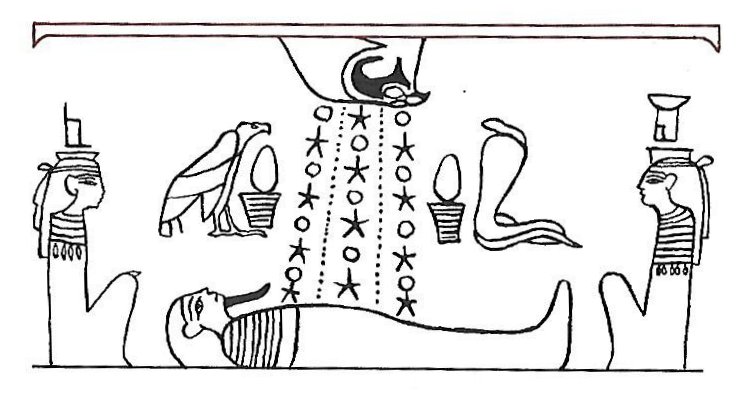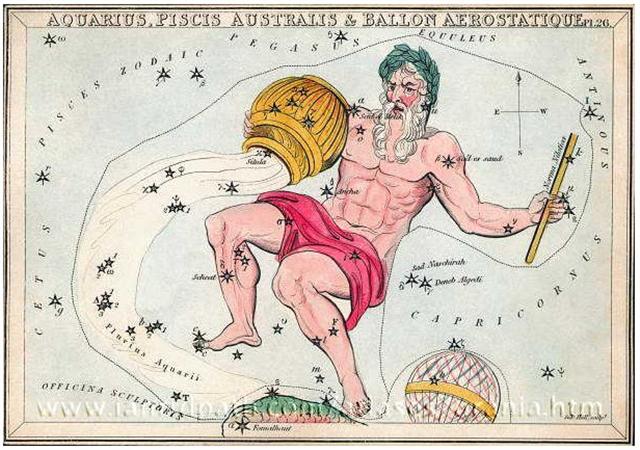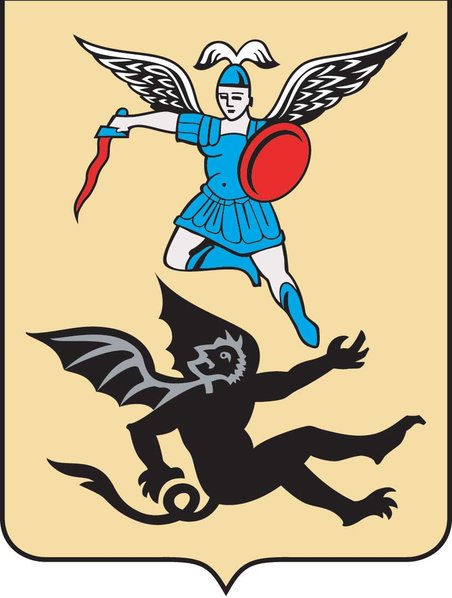The cosmological measures are still ruling us today. The 'upside down
canoe' below, for instance, was recently constructed in Germany
as a hangar for a zeppelin type of airship:

"After the Second World War worldwide only one big airship shed
had been built. The one in Brand south of Berlin for the
construction of the Cargolifter AG airship. With a length of 360
m, a width of 210 m and a height of 107 m it is one of the
largest unsupported structures in the world. After the
bankruptcy of Cargolifter AG it was converted into the leisure
center Tropical Islands." (Wikipedia)
It is 360 m long and 210 m wide, which immediately should
strike us as corresponding to the well-ordered 360 day long year
of the ancient Egyptians respectively to half the number of
their assessors down in the Underworld:

... The four bereaved and searching divinities, the two mothers
and their two sons, were joined by a fifth, the moon-god Thoth
(who appears sometimes in the form of an ibis-headed scribe, at
other times in the form of a baboon), and together they found
all of Osiris save his genital member, which had been swallowed
by a fish. They tightly swathed the broken body in linen
bandages, and when they performed over it the rites that
thereafter were to be continued in Egypt in the ceremonial
burial of kings, Isis fanned the corpse with her wings and
Osiris revived, to become the ruler of the dead. He now sits
majestically in the underworld, in the Hall of the Two Truths,
assisted by forty-two assessors, one from each of the principal
districts of Egypt; and there he judges the souls of the dead.
These confess before him, and when their hearts have been
weighed in a balance against a feather, receive, according to
their lives, the reward of virtue and the punishment of sin ...

42 was presumably short for 420 (because anciently zero was not
necessary for understanding). 42(0) = 7 * 6(0) corresponded to
the day when the Sun reached February 24 where in Roman times
the Moon had reached day 21(0) = 3 * 7(0):
|
tagata oho rima - ki te
marama |
koia kua oho |
ki te marama |
kua moe |
 |
 |
 |
 |
|
Ca6-17 (157 =
314 / 2) |
Ca6-18 |
Ca6-19 |
Ca6-20 |
|
CLOSE TO THE SUN: |
|
Febr 24 (420
= 7 * 60) |
25 |
26 |
27
(58 = 2 * 29) |
|
... The leap day was introduced as part of the
Julian reform. The day following the Terminalia
(February 23) was doubled, forming the 'bis
sextum - literally 'double sixth', since
February 24 was 'the sixth day before the
Kalends of March' using Roman inclusive counting
(March 1 was the 'first day'). Although
exceptions exist, the first day of the bis
sextum (February 24) was usually regarded as
the intercalated or 'bissextile' day since the
third century. February 29 came to be regarded
as the leap day when the Roman system of
numbering days was replaced by sequential
numbering in the late Middle Ages ... |
|
δ Tucanae (340.1), ρ Cephei (340.2), ν Gruis
(340.3), ζ Aquarii, δ Gruis (340.4), 5/1100 Lac.
(340.7), σ Aquarii, 6/650 Lac. (340.9)
*299.0 = *340.4 - *41.4
PROCYON (α Canis Minoris) |
υ Oct. (341.0), α/91 Lac. (341.1),
HOMAN (Hero) = ζ Pegasi,
β Piscis Austrini (341.2), ν Tucanae (341.5), υ
Aquarii (341.9) |
η Aquarii (342.1), σ Gruis (342.4),
SITULA (Water-jar) = κ Aquarii
(342.7)
*301.0 = *342.4 - *41.4 |
ε Piscis Austrini (343.5), ο Pegasi, β Gruis
(343.8) |
|
'Jan
28 |
29 |
30 |
31 (365 + 31
= 396) |
|
DAY 340 |
341 |
342 |
343 (= 7 *
7 * 7) |
 |
|
CLOSE TO THE
FULL MOON: |
|
Aug 25 (237 = 8 * 29˝ + 1) |
26 |
27 |
28 |
|
Extended Net-26b (Ox)
μ Hydrae
(157.1) |
Maru-sha-arkat-Sharru-15 (4th Son behind the
King)
SHIR (Possessing Luminous Rays) =
ρ
Leonis
(158.9) |
p
Carinae (159.3) |
φ
Hydrae (160.3) |
|
'July 29 (210) |
30 |
31 |
'Aug
1 |
|
DAY
157 |
158 |
159 |
160 |
The height of the German airship hangar was designed to
be 107 m, a measure which supports the idea that its
dimensions were made to reflect those of the cosmic order. As
above, so below.
Because in the framework of the Gregorian calendar we can
find 107 days as being equal to 80 (March 21) + 27 (the
precessional distance down from the time of rongorongo
to the time of Julius Caesar):
| te
henua |
te
honu kau |
manu
kake rua |
te
henua |
te
honu |
te
rima |
|
Kau. 1.
To move one's feet (walking or
swimming); ana oho koe, ana kau i te
va'e, ka rava a me'e mo kai, if you
go and move your feet, you'll get
something to eat; kakau (or also
kaukau), move yourself swimming.
2. To spread (of plants): ku-kau-áte
kumara, the sweet potatoes have
spread, have grown a lot. 3. To swarm,
to mill around (of people): ku-kau-á
te gagata i mu'a i tou hare, there's
a crowd of people milling about in front
of your house. 4. To flood (of water
after the rain): ku-kau-á te vai
haho, the water has flooded out (of
a container such as a taheta). 5.
To increase, to multiply: ku-kau-á te
moa, the chickens have multiplied.
6. Wide, large: Rano Kau, 'Wide
Crater' (name of the volcano in the
southwest corner of the island). 7.
Expression of admiration: kau-ké-ké!
how big! hare kau-kéké! what
a big house! tagata hakari kau-kéké!
what a stout man! Vanaga. To bathe,
to swim; hakakau, to make to
swim. P Pau., Mgv., Mq.: kau, to
swim. Ta.: áu, id. Kauhaga,
swimming. Churchill.
The stem kau does not appear
independently in any language of
Polynesian proper. For tree and for
timber we have the composite
lakau in various stages of
transformation. But kau will also
be found as an
initial component of various tree names.
It is in Viti that we first find it in
free existence. In Melanesia this form
is rare. It occurs as kau in
Efaté, Sesake, Epi, Nguna, and perhaps
may be preserved in Aneityum; as gau
in Marina; as au in Motu and
somewhere in the Solomon islands. The
triplicity of the Efaté forms [kasu,
kas, kau] suggests a
possible transition. Kasu and
kas are easy to be correlated,
kasu and kau less easy. They
might be linked by the assumption of a
parent form kahu, from which each
might derive. This would appear in
modern Samoan as kau; but I have
found it the rule that even the mildest
aspirate in Proto-Samoan becoming
extinct in modern Samoan is yet retained
as aspiration in Nuclear Polynesia and
as th in Viti, none of which
mutations is found on this record.
Churchill 2
Kaukau. 1.
Horizontal poles of a frame (of a
hare paega, or a paina
statue): he-hakatu'u te tama o te
paina, he-kaukau, they erect the
vertical poles of the paina then
they lay upon them the horizontal ones.
2. Group of people: e-tahi tuitui
reipá i Te Pei, ekó rava'a e-varu kaukau;
i-garo ai i Hiva, i te kaiga, a
necklace of mother-of-pearl is on te
Pei, few will find it (lit: eight
groups of people); it has remained in
Hiva, in our homeland. 3. To go
through, to pass through in unison;
he-hogi-mai te űka i te e'eo o te pua
kaukau-á i roto ite hare, the girl
smelt the fragrance of the pua
wafting inside the house. 4. Newborn
baby's first hand and feet movements (kaukau
or kau). The five
stages of a baby's development are:
kaukau, puepe, tahuri, totoro, mahaga.
Puepue = said of a newborn baby
when, a few weeks old, it begins to
distinguish people and objects:
ku-puepue-á te poki. Tahuri =
of a new-born baby, to move from side to
side: ku-tahuri-á te poki.
Totoro = to crawl; ki totoro te
poki, when the baby crawls.
Mahaga = baby when able to stand by
itself. Vanaga.

 |
 |
 |
 |
 |
 |
 |
|
*Ca14-24 |
*Ca14-25 |
*Ca14-26 |
*Ca14-27 |
*Ca14-28 |
*Ca14-29 (392) |
|
CLOSE TO THE FULL MOON: |
|
11 (159 +
308 - 366) |
April 12 (286 - 184) |
13 (468 = 365 + 103) |
14 (104 = 84 + 20) |
15 |
16 (392 - 366 + 80) |
|
δ Phoenicis (21.5) |
υ Andromedae (22.9) |
ACHERNAR
(End of the River) = α Eridani
(23.3), χ Andromedae (23.6), τ
Andromedae (23.9) |
ALSEIPH
(Scimitar) = φ Persei
(24.5), τ Ceti (24.7) |
no star listed (25) |
ANA-NIA-10 (Pillar-to-fish by)
χ
Ceti (26.1),
POLARIS
= α Ursae Minoris, BATEN KAITOS (Belly
of the Fish) = ζ Ceti
(26.6),
METALLAH = α Trianguli
(26.9) |
|
'March 15 |
16 |
17 (75) |
18 |
19 |
20 |

...
You are the one who shall stay here. We,
on the other hand, have to turn around.
Makoi replied, All right with me!
Then Ira continued to speak to
Makoi: Tomorrow, when it grows
light, set out and name the places
beginning with Apina. Makoi
replied, How shall I give the names?
Again Ira spoke, In Hiva
are the names that are to be taken to
name (the places of the new land). It
grew light and Makoi got up. He
set out and came to Apina. When
he arrived there, he gave the name
This is Apina Iti, this is Rapa Kura.
He went on and came to Hanga O Ua.
He gave the name This is Hanga O Ua
of the Beautiful Wave (vave renga).
Makoi went on, giving names,
until he had made a (complete) circle
around both sides (of the island). In
Apina Nui a stone (maea) was
erected, saying that the naming was done
on a (round) trip during a single day
...
 |
|
CLOSE TO THE SUN: |
|
12 (285 = 365 - 80) |
Oct 13 |
14 |
15 (288 = 96 + 192) |
16 |
17 (392 + 80 - 182) |
|
...
The canoes of Ava Rei Pua and of
Hotu were seen near the
(off-shore) islets. On the
fifteenth day of
the month of October (tangaroa
uri) the canoe of Hotu and
the canoe of Ava Rei Pua landed.
On the fifteenth day of the month of
October (tangaroa uri),
Nonoma left the house during the
night to urinate outside. At this point
Ira called out to Nonoma,
'Look at the canoe!' Nonoma ran,
he quickly went to Te Hikinga Heru
(a ravine in the side of the crater
Rano Kau) and looked around. There
he saw the double canoe way out near the
(offshore) islets, and the two (hulls of
the canoe) were lashed together. He ran
and returned to the front of the house.
He arrived and called into the house:
'Hey you! This canoe has arrived during
the night without our noticing it!'
Ira asked Nonoma, 'Where is
the canoe, which you say is lying out
there (in the water)?' Nonoma's
voice came back: 'It is out there (in
the water) close to the (offshore)
islets! There it lies, and the two
(hulls) are lashed together.' The four
of them (corrected for 'the six of
them') went out and picked up leaves (on
branches) to give signals. They picked
them up, went and arrived at Te
Hikinga and saw the canoe.
Raparenga got up, picked up the
leaves, took them in his hands, and
waved, waved, waved, waved ... (E:75) |
|
HEZE =
ζ
Virginis
(205.0),
Southern Pinwheel Galaxy = M83 Hydrae
(205.7) |
ε Centauri (206.3), κ Oct. (206.4)
*165.0 = *206.4 - *41.4 |
no star listed (207) |
τ
Bootis (208.2),
BENETNASH
(Leader of the Daughters
of the Bier) = η
Ursae Majoris
(208.5),
ν
Centauri (208.7),
μ
Centauri,
υ
Bootis (208.8) |
no star listed (209) |
MUPHRID
(Solitary Star) = η Bootis
(210.1), ζ Centauri (210.3) |
|
'Sept 15 |
16 |
17 (260) |
18 |
19 |
20 |
|
E tupu |
ki roto |
o te
hau tea |
ki te
henua - te maro |
 |
 |
 |
 |
|
CLOSE TO THE FULL MOON: |
|
Cb1-1 (*27) |
Cb1-2 |
Cb1-3 |
Cb1-4 (396) |
|
April 17 (107) |
18 |
19 |
20 |
|
Al Sharatain-1 /
Ashvini-1 /
Bond-16 (Dog) /
Mahrū-sha-rishu-ku-1 (Front of the Head
of Ku)
SEGIN =
ε
Cassiopeia,
MESARTHIM =
γ
Arietis,
ψ
Phoenicis (27.2),
SHERATAN (Pair of Signs) =
β
Arietis,
φ
Phoenicis (27.4)
*351.0 = *27.4 - *41.4 |
ι Arietis (28.0), λ Arietis (28.2), υ
Ceti (28.8) |
ALRISHA (The Knot) = α Piscium,
χ Phoenicis (29.2), ε Trianguli (29.4), ALAMAK (Caracal) = γ Andromedae
(29.7)
*353.0 = *29.4 - *41.4 |
Arku-sha-rishu-ku-2 (Back of the Head of
Ku)
2h (30.4)
κ
Arietis (30.3),
HAMAL (Sheep)
=
α
Arietis
(30.5)
ALKES (α
Crateris)
*354.0 = *30.4 - *41.4 |
|
'March 21 (107 - 27) |
22 |
23 |
24 |
 |
 |
 |
 |
 |
|
Cb1-5 |
no star listed (366 + 32) |
MIRA
= ο Ceti |
Cb1-8 |
Cb1-9 (*35) |
|
... Although an
old constellation, Cetus is by no
means of special interest, except as
possessing the south pole of the
Milky Way and the Wonderful Star,
the variable Mira; and from the fact
that it is a condensation point of
nebulae directly across the sphere
from Virgo, also noted in this
respect ...

... Mira
also known as Omicron
Ceti (ο
Ceti, ο
Cet), is a red giant star estimated
200-400 light years away in the
constellation Cetus. Mira is a
binary star, consisting of the red
giant Mira A along with Mira B. Mira
A is also an oscillating variable
star and was the first non-supernova
variable star discovered, with the
possible exception of Algol. Apart
from the unusual Eta Carinae, Mira
is the brightest periodic variable
in the sky that is not visible to
the naked eye for part of its cycle
...
In a way Mira
therefore can illustrate how life
(light) departs, yet returns again
after the completion of a cycle.

... In 1638
Johannes Holwarda determined a
period of the star's reappearances,
eleven months; he is often credited
with the discovery of Mira's
variability. Johannes Hevelius was
observing it at the same time and
named it 'Mira' (meaning 'wonderful'
or 'astonishing,' in Latin) in
1662's Historiola Mirae Stellae,
for it acted like no other known
star. Ismail Bouillaud then
estimated its period at 333 days,
less than one day off the modern
value of 332 days, and perfectly
forgivable, as Mira is known to vary
slightly in period, and may even be
slowly changing over time ... |
|





















